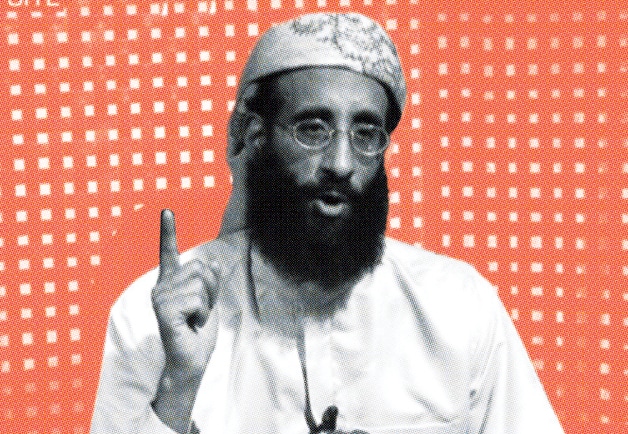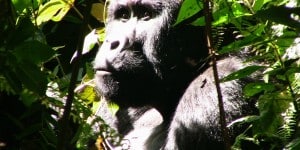With Osama dead, U.S. intelligence is zeroing in on the remaining most dangerous terrorists alive, and one man is at the top of the list. Of the eighteen terror attacks attempted in the United States over the past two years, Anwar al-Awlaki’s fingerprints are on eight of them. The moderate turned radical is eloquent, he is popular — and he’s American. Patrick Symmes travels to Awlaki’s new base, the wilds of Yemen, to search for public enemy number one
It was the first drone attack in Yemen in a decade. On May 5, three days after Osama bin Laden was killed, a weaponized unmanned aircraft flew at 20,000 feet over the cracked and broken topography of Yemen. The target was a pickup truck carrying two men, one of them an American-born cleric named Anwar al-Awlaki.
U.S. intelligence had been tracking him for years. Last July, Awlaki had been seen in Shabwa Province, a restive Al Qaeda stronghold in southern Yemen, where he was said to have recruited hundreds of young loyalists. This May the Yemeni government tipped off U.S. forces that Awlaki was there again, hiding in the village of Abdan. About seventy-five American Special Forces are in Yemen, supposedly on a training mission. When a pickup truck carrying the cleric left Abdan, the drone controlled by either the CIA or Joint Special Operations Command followed. Somebody took a shot at Awlaki.
And another shot. And another shot.
Incredible luck? Expert off-road driving? However it happened, Awlaki survived the first, the second, and the third drone strikes. All three missiles missed. The pickup truck was said to be “lightly damaged,” according to a village source, and Awlaki was unharmed.
By now he could be anywhere—a shepherd’s hut outside Mar’ib, the Al Qaeda capital of Yemen; a comfy pad outside cities like Aden or Taiz; or as a senior Western diplomat in Sanaa suggested, hiding among his ancestral clan members, the Awlakis, a powerful tribe that has ruled parts of southern Yemen for generations.
Wherever he is, Awlaki is only hiding physically. Unlike Bin Laden, who limited himself to the occasional thumb drive, Awlaki has spent the last two years going online routinely, firing off e-mails and posting web videos. His sermons, given in beautiful idiomatic English, are sold in sixteen- and eighteen-part CD collections, with sweet-sounding themes like Islamic motherhood or “Tolerance—A Hallmark of Muslim Character,” but he reaches quickly for the big stick. “Allah will take those false gods,” he says of non-Muslims, in a sermon ostensibly about police brutality, “and throw them in hellfire, and their people will have to follow them.”
“In the West, Bin Laden’s preaching is not effective,” says Saeed Ali al-Jemhi, a kind of one-man anti–Al Qaeda think tank whom I met with in Yemen in March, when Bin Laden was still alive. “But Awlaki, they listen to him once or twice, they are in. He’s the radical magnet. He gave Al Qaeda a fifty-year push forward, an evolution.”
Awlaki ran a blog until that was shut down, flooded YouTube until that was shut down, and spews e-mails, audio files, and videos to a constantly changing array of sympathetic websites. It took me about ten minutes to find all the sermons that were banned from YouTube. Despite a lot of Islamic jargon, you can hear his emotional appeal as he raps in English about repression (“Five hundred and twenty-eight Muslims were arrested under these new laws!”) and the supreme courage it takes to become God’s armed defender. In a how-to guide titled “44 Ways to Support Jihad,” he says, “Jihad today is obligatory on every capable Muslim. So as a Muslim who wants to please Allah it is your duty to find ways to practice it and support it.” In the midst of hiding from American drones, he still found time to write for Inspire, the snappy English-language magazine of Al Qaeda, a manual for waging jihad. (Inspire strikes a bizarrely knowing, ironic tone, advising potential contributors, “Humor is a plus!”)
“He is Al Qaeda’s voice to Muslims in the West,” says Gregory Johnsen of Princeton, who lived in Yemen and studies Al Qaeda in the Arabian Peninsula (AQAP). “Al Qaeda was passive in recruiting Westerners, waiting for them to come. Awlaki is very different. He is quite active going after these Westerners.”
Active enough to inspire at least eight of the past eighteen reported terror plots on American soil and land himself on the CIA’s list of targets for killing—one of roughly thirty people subject to long-range assassination by the U.S. government. His most obvious success was the alleged Fort Hood assassin, Major Nidal Hasan, an army doctor charged with killing a dozen soldiers and a civilian during a shooting rampage in November of 2009. Major Hasan and Awlaki exchanged at least eighteen e-mails, almost all from Hasan to Awlaki, listing supposed Sharia justifications for why one could kill U.S. soldiers. Awlaki sent him two or three e-mails, by his own account, encouraging martyrdom. Signing off, Hasan wrote, “I can’t wait to join you” in paradise.
A less lethal example came six months later in England, where a would-be killer named Roshonara Choudhry, 22, stabbed a member of Parliament in the stomach twice, after listening to a hundred hours of sermons by Awlaki. The cleric advised another recruit, “Our highest priority is the U.S.” The recipient, a 31-year-old volunteer named Rajib Karim, was an IT expert at British Airways who offered to exploit his position to blow up a plane. “The question is,” Awlaki wrote, “with the people you have is it possible to get a package or a person with a package on board a flight heading to the US? Anything there, even on a smaller scale compared to what we might do in the UK, would be our choice.”
After Bin Laden’s death, warns former FBI agent Ali Soufan, Al Qaeda will reshu±e. “Al Qaeda claims to be a religious organization,” he notes, “but they don’t have a known cleric. In the absence of Bin Laden, there is this guy who is Yemeni, who can unify the Arabian Peninsula factions, and who is also a cleric who speaks English well. He has a big potential to be the person who might try to fill Bin Laden’s shoes.”
Awlaki was born in Las Cruces, New Mexico, on April 22, 1971. His father was studying at New Mexico State University on a Fulbright, the scholarship designed to expose foreigners to our values. Young Anwar was carted around the States for years as academic baggage—New Mexico, Nebraska, Minnesota—but at age 7 he moved to Yemen with his family. The father became a great man at home: professor, dean, university president, government minister, adviser to the president.
While Anwar’s childhood was in America, his formative years were in the embrace of one of the most traditional societies on earth. He returned to the States only for college, a pious young man who entered Colorado State University in Fort Collins in 1991. “That was a long time ago,” says his faculty adviser from those days. Johannes Gessler was then, and still is, a professor of engineering. Anwar, studying civil engineering, was assigned to him at random for mentoring. Gessler says that they met once a semester, talking about course loads, credits, and career plans. Awlaki “followed the norm,” dressed like other students, wore the usual jeans and caps, and was “under the radar, blending in perfectly, which makes the shock even bigger when you find out who he became.”
During the same period at Colorado State, Awlaki was elected student leader at the campus mosque, a centrist put forward to head off the candidacy of a conservative. Indeed, Anwar the American began his life as a holy man the American way: elected, positioning himself in the middle. After September 11, the FBI interviewed him repeatedly—not as a suspect but as a source on Islamic radicals. He was invited to the Pentagon as part of a Muslim-outreach program in 2002 after a Defense Department employee was “impressed” by one of his sermons; Awlaki later led a prayer at the Capitol. Interviewed on PBS, he bluntly attacked U.S. foreign policy but said that nothing justified the attacks on New York and Washington and called for “freedom and human rights in the Middle East.”
After graduating from Colorado State, he began a master’s in educational leadership at San Diego State. Years later, the September 11 commission would look back carefully at Awlaki’s record in California. At San Diego’s Arribat al-Islami mosque, he was head Imam in 2000, the year two young men—Nawaf al-Hazmi and Khalid al-Mihdhar—began attending prayers. In February of 2000, a phone used by the two men called Awlaki four times, but there is no evidence he knew they were on a mission that would end in suicide at the Pentagon. Even before the attacks, the FBI had been investigating the San Diego mosque for potential radicals but labeled Anwar a “moderate.”
Apparently addicted to U.S. higher education, Awlaki went for a Ph.D. at George Washington University in Washington, D.C. He didn’t complete his doctorate, but as in San Diego, he joined one of the metro area’s largest mosques and began to rise within it, eventually becoming the head Imam at Dar Al-Hijrah, located in Falls Church, Virginia.
In 2002, soon after Awlaki was trotted out in Washington, he was asked to preach in England, his growing fame allowing him to tour the country’s mosques. He then visited family in Yemen. On his return to America, he was detained about a minor matter—at Colorado State, he’d applied for financial aid by pretending he was not a U.S. citizen. But the Colorado D.A. had dropped an arrest warrant for the lie, and he was let back into the States.
Awlaki lived in England with his wife and children until 2004, when he moved back to Yemen. He was arrested there in 2006 and detained for allegedly participating in the kidnapping of a Shiite, the Muslim minority hated by the Sunni-dominated Al Qaeda. Awlaki said he had merely been an “arbitrator” in a tribal dispute. He was never charged by the Yemeni government, and he suggested, in an interview with Cageprisoners.com, a site devoted to supporting Islamists in Guantánamo and other jails, that he was held only so that U.S. officials could interrogate him.
Although there was speculation that his time in jail radicalized him, Awlaki described a mundane prison term that lasted one and a half years. He complained about the lack of exercise but appreciated the time he had to read the Koran. His first nine months were in an underground cell, eight feet by four with a twelve-foot-high ceiling, and FBI agents were among his only visitors. He was interrogated with “some pressure,” Awlaki said, but this wasn’t waterboarding: When he complained, the agents supposedly apologized, and during the second half of his term he was given books, pen and paper, a roommate, an aboveground cell three times as large, frequent family visits, and home-cooked meals delivered to the prison twice a week. His bitterest comment was about the lack of sunlight.
The FBI asked about his associates in Yemen and the presence of two September 11 hijackers at his mosque in San Diego. He dismissed any claim that he was an Al Qaeda loyalist, which was probably true at that point. He denied that he was connected to the September 11 plot, which was also probably true. Maybe Awlaki gamed the bureau, but more likely his radicalization came later than anyone speculated.
The first Al Qaeda–like language wouldn’t appear on Awlaki’s now-defunct blog until 2009: “I pray that Allah destroys America and all its allies. And the day that happens, and I assure you it will and sooner than you think, I will be very pleased.” This was a year and a half after Awlaki was in prison, where he passed as a quiet preacher. He was released from jail in late 2007 and, according to his father, disappeared into lawless Yemen eight months later.
There are mountains, there are deserts, and then there is the rare place made of both: That is Yemen. The ruggedness never stops. In the north are the high peaks of the Arabian Shield, and moving south you come, as I did in March, to the Jabal Haraz, a grim range of mountains where biblical-looking men tote AK-47’s in the street markets. To the east, the mountains fade out slowly, leaving a series of titanic wadis, or dry river valleys, like Wadi Doan, the poor valley that Osama bin Laden’s father left for the riches of Saudi Arabia around 1930. Where the mountains end, there is the Empty Quarter—the harshest desert in the region. I flew over Yemen’s south, getting a feel for how it must look through the lens of a drone: an impossible frieze of cracked-stone ridges, rippling black mountains, and brown, waterless deserts, often roadless and obscured by dust storms.
Even the capital of Yemen, the medieval wonder of Sanaa, is located at 7,000 feet. When I was there a few months ago, I found the city center filled with democratically minded young protesters eager for their own version of the Arab Spring. “We want reforms, salary increases, an economy with prosperity, better education, better higher education, and security and stability,” a young farmer said. Awlaki and his colleagues claimed a return to an Islamic emirate was coming. And President Ali Abdullah Saleh exploited this specter—après moi le déluge—to neutralize American criticism and remain in power, infuriating the demonstrators, who insist Saleh is the real cause of chaos. The farmer told me he’d had enough of authoritarian leaders dictating loyalties. “No more vendettas,” he said.
But Yemen is still an autocracy. To prevent my going back to interview more protesters, Yemen’s security apparatus attached a minder to me. A few days after that, I was stopped in Sanaa by agents of the National Security Council, who confiscated my passport. After fourteen hours of harmless detention, I was put on the next flight out of the country.
Like many a tyrant, President Saleh is better at deporting journalists and cracking the skulls of his own people than he is at fighting the real bad guys. Before I was taken into custody, I toured a military base in Sanaa protected by armored vehicles bristling with machine guns. The spectacle of force would have been more impressive if the guards had not been lounging barefoot in the shade of the walls, their guns cast aside and their mouths bulging with wads of khat, the narcotic leaf that is ubiquitous here, chewed the way Americans linger over afternoon cappuccinos.
With my departure clock ticking, I moved on to an elite neighborhood called Hadda, where one man is waging a war of ideas against Al Qaeda in the Arabian Peninsula. I met Saeed Ali al-Jemhi at his think tank on Zero Street. The author of a dense book on the group’s history and internal divisions in Yemen, Jemhi sat me down in a spacious office decorated with little more than a Koran and a penholder with a matching clock and desk pad.
“Because of Awlaki, Al Qaeda has extended its limits,” he said, nervously stroking his beard. “Now they can attack London, the U.S., from within.” Zero Street is the kind of place where a pissed-off jihadi might show up, but Jemhi is unguarded in his critique of what radical Islam has done to Yemen. Violence has torn up the society in recent years; beheadings and assassinations are not unknown; Shiites in particular are derided as heretics and targeted by Al Qaeda fanatics in the north; AQAP has repeatedly struck in downtown Sanaa, attacking army bases and twice ambushing the British ambassador. Jihadi violence has also become a prop to keep President Saleh in power for over three decades. Yemen has never been in worse shape. “Al Qaeda is not a political group but a killing group,” Jemhi said. “They should be beaten.”
Sanaa is a tight society, and I was hardly surprised when Jemhi revealed that he had been a neighbor of the Awlaki family a few years ago. Although he never knew Anwar, he spent time with the father, Nasser, who declined to speak with me for this story. More than once, Nasser told him, “I like Americans. America is good.” However, Jemhi said he couldn’t help bragging that the boy had gone big-time. “My son,” he told Jemhi, “has a twenty-eight-page entry on Wikipedia.”
Jemhi sighed. “The father has taken pride in his son being famous,” he said. “Even if it is for terrorism.”
“Don’t consult with anyone in fighting the Americans,” Awlaki once instructed. “Fighting the devil doesn’t require consultation or prayers or seeking divine guidance.” With statements like this, Awlaki is issuing direct commands to jihadis, urging violent chaos on the far enemy. “We believe he is operational,” the senior Western diplomat in Sanaa told me, meaning Awlaki plays some direct role in planning terrorist attacks, not just in inspiring them. “There’s no question Al Qaeda senior leadership look at Awlaki as their best asset in reaching out to the U.S. and the West,” the diplomat said.
Yet in the spring issue of Inspire magazine, Awlaki focused his attention much closer to home. Other leading Al Qaeda figures, like the Egyptian doctor Ayman al-Zawahiri, issued bumbling statements in the face of the mass revolutions that swept from Tunisia into Egypt and caught fire, at least briefly, in Libya, Yemen, Bahrain, Jordan, and Syria. But Awlaki predicted that protesters would topple “the rest of America’s servants…from Morocco to Pakistan.” Holy warriors would exploit the new opening. The Arab Spring was “good for the mujahideen, and bad for the imperialists of the West and their henchmen in the Muslim world,” he wrote.
Still, within the hierarchy of AQAP, which values grizzled veteran mujahideen warriors above all, Awlaki is an anomaly—more of a thinker than a fighter. He has been incorrectly cited as the leader of AQAP; that would actually be Bin Laden’s old secretary, the weasel-faced Nasir al-Wuhayshi. Awlaki remains an up-and-comer. “A couple of years ago, Awlaki was an absolute unknown in the Arab world and Yemen,” says Johnsen. “The more the Obama administration talks about him, the more AQAP seizes on that as almost free advertising. The more the U.S. talks about him, the more AQAP pushes him forward.”
And the more they push him forward, the more they put him at risk. On the day of the drone attack near Abdan village, after the third missile missed, the drone recalibrated and came back for another pass about forty-five minutes later. By then Awlaki had switched vehicles with two Yemeni brothers, local supporters who had rushed to his aid. A fourth missile torched the truck Awlaki had been driving, killing the brothers; Awlaki drove away in their car. It was an escape that could earn Anwar the American some war cred, the kind of combat-survival story that builds a man’s legend within Al Qaeda. As Jemhi had told me in his office: “In Al Qaeda, if you are murdered, you are a martyr. If you survive, you are a hero.”




